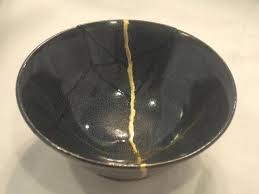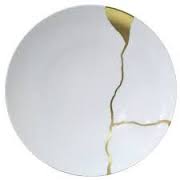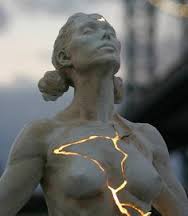KINTSUGI - Bringing Beauty out of Brokeness
By Sarah Hawthorne
Most of us were taught to repair brokenness in a manner that hides the crack, so there is no external sign of the trauma the ceramic has survived. If a broken ceramic cannot be restored to “perfection”, it is often discarded.
In 2009 the exhibition "Golden Seams: The Japanese Art of Mending Ceramics" drew acclaim at the Smithsonian's Freer Gallery. Surprisingly, each of the proudly displayed thirteen ceramics from China, Vietnam, Korea and Japan, all featured very visible cracks.
“Kintsugi” is the art of fixing broken ceramics with a lacquer resin of gold or silver, so that the filling which holds the shards together actually highlights, rather than hides, the crack. The literal translation of kintsugi is “golden joinery.” A ceramic so repaired is considered more beautiful and valuable than before the fracture.
It is said that this practice began in the late 15th century, when the Japanese shogun Ashikaga Yoshimasa was extremely disappointed in the ugly metal staples used by Chinese craftsmen to repair his broken Chinese tea bowl. Thus began a quest by Japanese craftsmen to invent a new method of repairing ceramics that would produce an aesthetically stunning product upon completion. In the end, it was said that Japanese collectors became so fond of kintsugi art that some were believed to deliberately break prized ceramics in order to request kintsugi mending!
A contemporary Japanese kintsugi master is Tsukamoto Showzi, who began his kintsugi studies in 1972, and opened a Kintsugi School in 2000. Click here to see a one minute YouTube video of him repairing a bowl.
 The integrity of kintsugi is its commitment to honestly reveal past experiences that demonstrate the ceramic’s fragility and vulnerability. It seems to me that the essence of our nature as humans is also vulnerability, and the secret of our longevity lies not in our ability to imperviously withstand pressure in the hope of staying the same, but rather in our ability to respond and change.
The integrity of kintsugi is its commitment to honestly reveal past experiences that demonstrate the ceramic’s fragility and vulnerability. It seems to me that the essence of our nature as humans is also vulnerability, and the secret of our longevity lies not in our ability to imperviously withstand pressure in the hope of staying the same, but rather in our ability to respond and change.
It seems to me we do best when we temporarily yield to the external forces in our lives and truthfully absorb the experience by acknowledging its impact. By so doing, we release the pressure in the form of a fissure from which we may mend and continue on as something new, something that now bears the mark of our past experience and shows without shame whom we have become.
something that now bears the mark of our past experience and shows without shame whom we have become.
While it may be tempting to camouflage the evidence of our lifetime of experiences in an effort to restore our appearance to its original “perfection”, it is worth nothing that factory-issued ceramics are identical, whereas a ceramic that has been broken and restored by a kintsugi artist is  entirely unique and unreproducible. Not only are the cracks from the break distinctly different in each ceramic, but there is no mistaking the golden lines of kintsugi, as they are acquired at a time distinctly later in life than when the ceramic was new.
entirely unique and unreproducible. Not only are the cracks from the break distinctly different in each ceramic, but there is no mistaking the golden lines of kintsugi, as they are acquired at a time distinctly later in life than when the ceramic was new.
Even more important than showing our personal resilience, the vein of the gold/silver thread of lacquer resin holding our brokenness together is evidence of our spirit at work. The beauty that shines forth from those places where our spirit has mended us gives witness to the purpose and meaning of our lives.